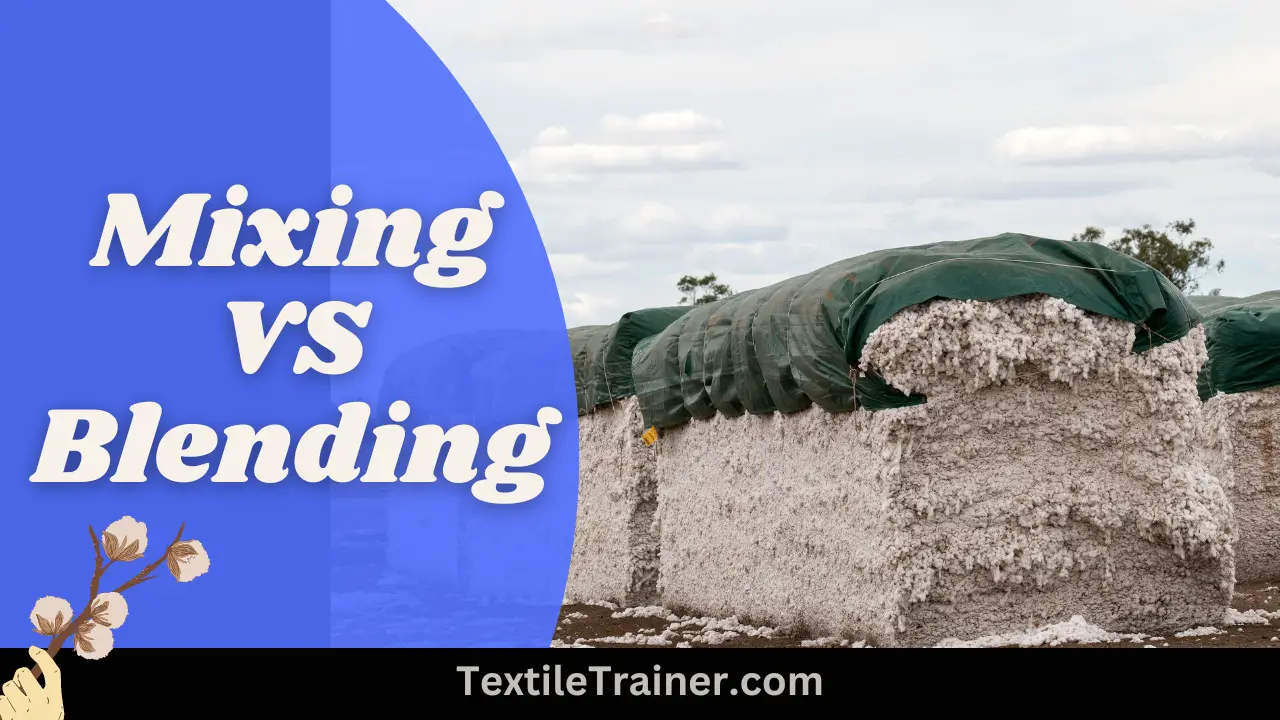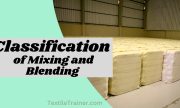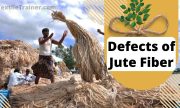What is Mixing?
Mixing: when the same kind but different grades of fibers are combined together, then it is called mixing. In other words, the Mixturing of some fibers from different grades or from the same origin are taken together for a product is called mixing.
Example: Low-graded cotton + high-graded cotton= Mixing.
What is Blending?
Blending: when different types of fibers, which may be equal or nearly equal graded, are mixed within a particular ratio, the mixture is called blending. In other words, Different fibers from the same or different grades and different origins are taken together for a product is called blending.
Example: 40% polyester+ 60% cotton= blending.
Products with blends, mixtures, and combinations may have properties that differ from those obtained with a single fiber. Blending may add value and may reduce the cost of the product. For example, cotton is often mixed with other fibers, particularly synthetics. This blending can make cotton-like fabrics with improved functionality, such as wrinkle resistance and dimensional stability. The addition of spandex to cotton improves the stretch of the product.
Importance of mixing and blending:
- To give the required characteristics to the end product.
- To compensate for variations in the features of the raw materials.
- To hold down raw materials cost.
- To achieve the effect by varying color, fiber characteristics, etc.
- To achieve uniform quality.
- To use waste cotton in mixing.
- To meet function and end-user requirements.
Mixing and blending influences the reduction of the final product through blend composition, availability of fiber quality and inherent fiber properly variations. Blending influences the process performance of carding through control of neps level variation, waste level variation, fly, roving twist variation, machine adjustment, static electricity formation. It also influences the processing performances of spinning through control of yarn twist variation, end breakage, machine adjustments etc. Mixing and blending also influences in weaving, dyeing and finishing. some functional properties are influenced by mixing and blending. It increases comfort and the properties like handling, abrasion resistance, stretch etc.Following factors to be considered in-case of mixing and blending. They are:
- Fiber length.
- Color.
- Fineness.
- Tuff.
- Flexibility
Difference between mixing and blending:
| Mixing | Blending |
| 1. When same kind but different graded of fibers are mixed together than it is called mixing. | 1. When different types of fibers it may be equal or nearly equal graded are mixed together are within a particular ratio then the mixture is called blending. |
| 2. Mixing is done in the blow room. | 2. Blending is done in the draw frame. |
| 3. Physical properties of mixing all fibers are same. | 3. Physical properties of blending all fibers are not same. |
| 4. Mixing is carried out for profiling of quality and cost of yarn. | 4. Blending is carried out for profiling of quality properties of garments. |
| 5. Importance of component to the resultant yarn is at lower level. | 5. Importance of component to the resultant yarn is a higher level. |
| 6. Mixing operation is easy | 6. Blending operation is difficult. |
| 7. Same kind but different graded of fibers are mixed together. | 7. Different types of fibers and equal or nearly equal graded fibers are mixed together. |
| 8. There is no particular ration of fibers to mix with each other. | 8. There is a particular ratio of fibers to mix with each other. |
| 9. It is a costly process. | 9. It is a cheap process. |
| 10. 60% grade-1 cotton+ 40% grade-2 cotton= mixing. | 10. 60% cotton + 40% polyester= blending. |
If this article I tried my best to present differences between mixing vs blending. Feel free to ask me any textile relate question by comment box.
References:
- Chowdhury, M. F. (2016). Manual of Short Staple Spinning . Dhaka: Granthanir Prokashoni.
- Hossain, M. S. (2014). Introduction to Textile Engineering. Dhaka: Books Fair Publications.
- Kadolph, S. J. (2009). Textiles. New Delhi: Dorling Kindersley.
- Siddique, D. H. (n.d.). Natural Fibers. Dhaka.







Im grateful for the blog post.Much thanks again. Really Great.
thanks.
Thanks again for the blog article.Really thank you! Cool.
thanks too….please support us….
Im obliged for the article. Much obliged.
Keep visit our site..
I truly appreciate this article.Much thanks again. Really Great.
keep visit our site…..
Say, you got a nice post.Really looking forward to read more. Will read on…
ok….
Thanks for sharing, this is a fantastic article post.Really looking forward to read more. Want more.
keep visit our site..
I value the article post. Great.
please support us.
Great, thanks for sharing this blog article. Really Great.
keep visit our site..
I value the post.Much thanks again. Great.
keep visit our site.
Thanks for sharing, this is a fantastic blog.Really thank you! Keep writing.
keep visit our site…..
A big thank you for your blog.Really thank you! Much obliged.
I appreciate you sharing this blog.Really looking forward to read more. Awesome.
Im thankful for the post.Much thanks again. Much obliged.
Really informative blog post.Really thank you! Great.
I appreciate you sharing this blog.Really thank you! Cool.
Very neat blog post. Much obliged.
keep visit our site….
Appreciate you sharing, great blog article.Really looking forward to read more. Cool.
A round of applause for your article.Much thanks again.
I really enjoy the blog.Really looking forward to read more. Keep writing.
Thanks for the blog post.Much thanks again. Really Great.
Im grateful for the blog. Really Cool.
Great article post.Really thank you! Cool.
Thanks for the blog post.Much thanks again. Cool.
Im thankful for the post.Really thank you! Really Cool.
Wow, great article.Really looking forward to read more. Will read on…
Really informative article post.Really looking forward to read more. Fantastic.
I really liked your blog article.Thanks Again. Keep writing.
Looking forward to reading more. Great article post.Really looking forward to read more. Really Great.
Thank you ever so for you blog article.Really thank you! Really Great.
Appreciate you sharing, great blog post.Really thank you! Want more.
I appreciate you sharing this post.Much thanks again.
Im grateful for the blog.Thanks Again. Will read on…
This is one awesome blog.Really thank you! Cool.
I truly appreciate this blog post.Really looking forward to read more. Will read on…
Very neat blog article.Really thank you! Much obliged.
I appreciate you sharing this blog article. Awesome.
Thanks so much for the article post.Much thanks again. Really Great.
This is one awesome article.Really looking forward to read more. Want more.
I really liked your article. Really Cool.
Thanks again for the blog. Awesome.
Very neat blog article.Thanks Again. Cool.
I loved your article.Much thanks again. Want more.
Im obliged for the blog article.Really looking forward to read more. Cool.
Thank you for your post. Keep writing.
Say, you got a nice blog.Really thank you! Want more.
Thank you ever so for you article post.Really thank you! Want more.
I really enjoy the blog.Much thanks again. Great.
Say, you got a nice article.Really looking forward to read more. Cool.
I value the blog.Really thank you! Keep writing.
I really enjoy the article post. Really Cool.
I loved your post.Really thank you! Will read on…
Looking forward to reading more. Great article.Much thanks again. Will read on…
Fantastic blog. Cool.
I truly appreciate this article.Thanks Again. Really Great.
Awesome post.Really looking forward to read more. Fantastic.
Really appreciate you sharing this article. Keep writing.
google
I loved your article.Really thank you! Really Cool.
Really appreciate you sharing this article post.Much thanks again. Much obliged.
I really enjoy the post.Thanks Again. Much obliged.
I cannot thank you enough for the blog post.Thanks Again. Great.
Enjoyed every bit of your blog post. Awesome.
Looking forward to reading more. Great article post.Really thank you! Much obliged.
Hey, thanks for the post.Really thank you! Really Great.
Really appreciate you sharing this article post.Thanks Again. Really Great.
Thank you for your article.Thanks Again.
Very good article.Much thanks again.
Very informative article.Really thank you! Will read on…
Great blog article. Fantastic.
Awesome article post. Cool.
I really enjoy the blog. Great.
I think this is a real great blog.Really looking forward to read more.
Thanks so much for the article post.Really thank you!
Really enjoyed this article.Thanks Again. Great.
Great, thanks for sharing this blog post. Really Cool.
I value the blog.Thanks Again. Really Cool.
Thank you for your blog article.
Thanks
I truly appreciate this blog article.Thanks Again. Fantastic.
Im obliged for the post. Really Great.
Very good article.Thanks Again. Want more.
Thanks so much for the article post. Cool.
Enjoyed every bit of your article post.Thanks Again. Keep writing.
I think this is a real great blog article.Thanks Again. Really Great.
I really like and appreciate your blog post.Much thanks again. Much obliged.
Im thankful for the blog article. Will read on…
Im grateful for the blog post.Thanks Again. Want more.
I really like and appreciate your article.Thanks Again. Keep writing.
I am so grateful for your blog post.Really thank you!
Thanks for sharing, this is a fantastic blog.Thanks Again. Really Great.
I am so grateful for your article post. Cool.
Very good blog.Really thank you! Cool.
Say, you got a nice blog post. Awesome.
Major thanks for the post. Great.
Magnificent article! If you require a writer, I’m here and passionate about writing
Say, you got a nice article.Thanks Again. Great.
Thank you for your article post.Really thank you! Will read on…
Im grateful for the blog article.Much thanks again. Cool.
Very good post.Really looking forward to read more. Cool.